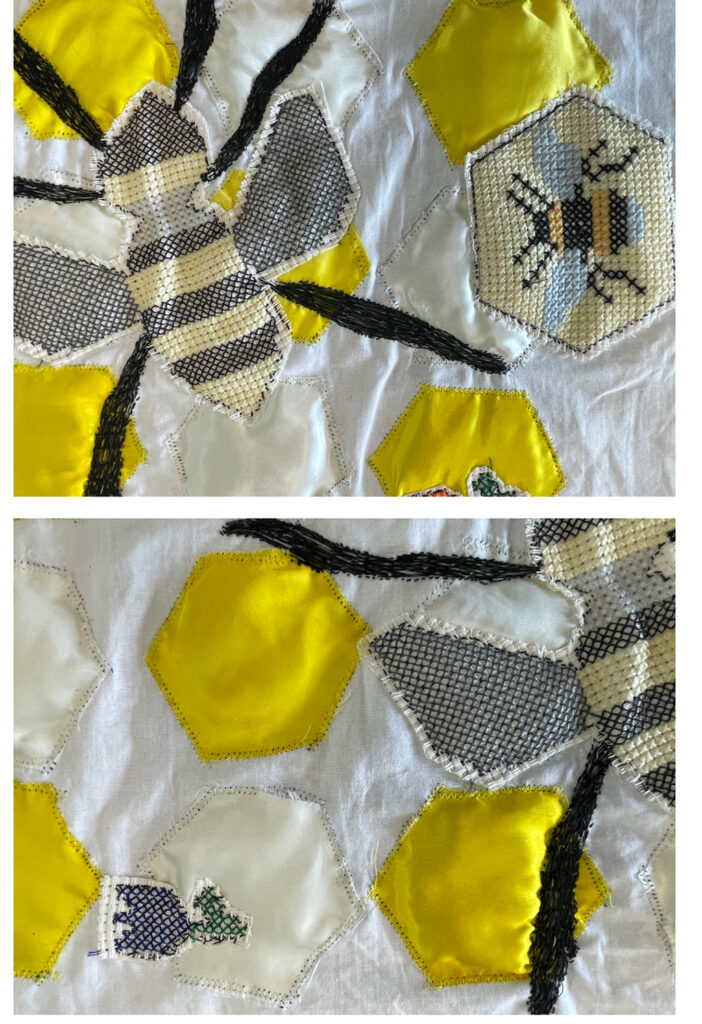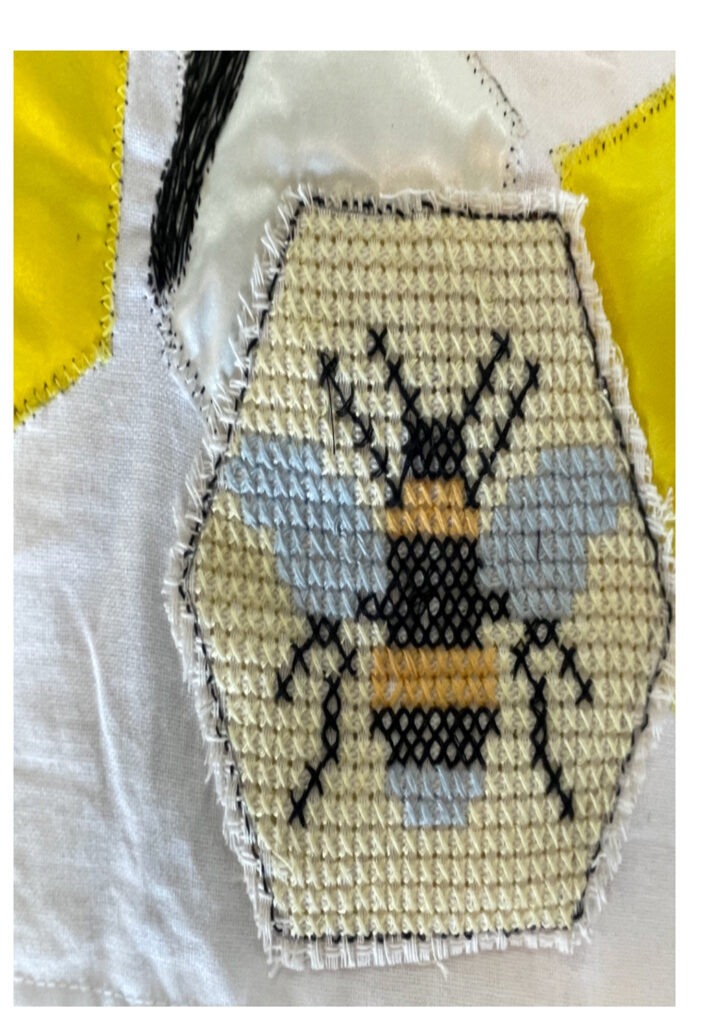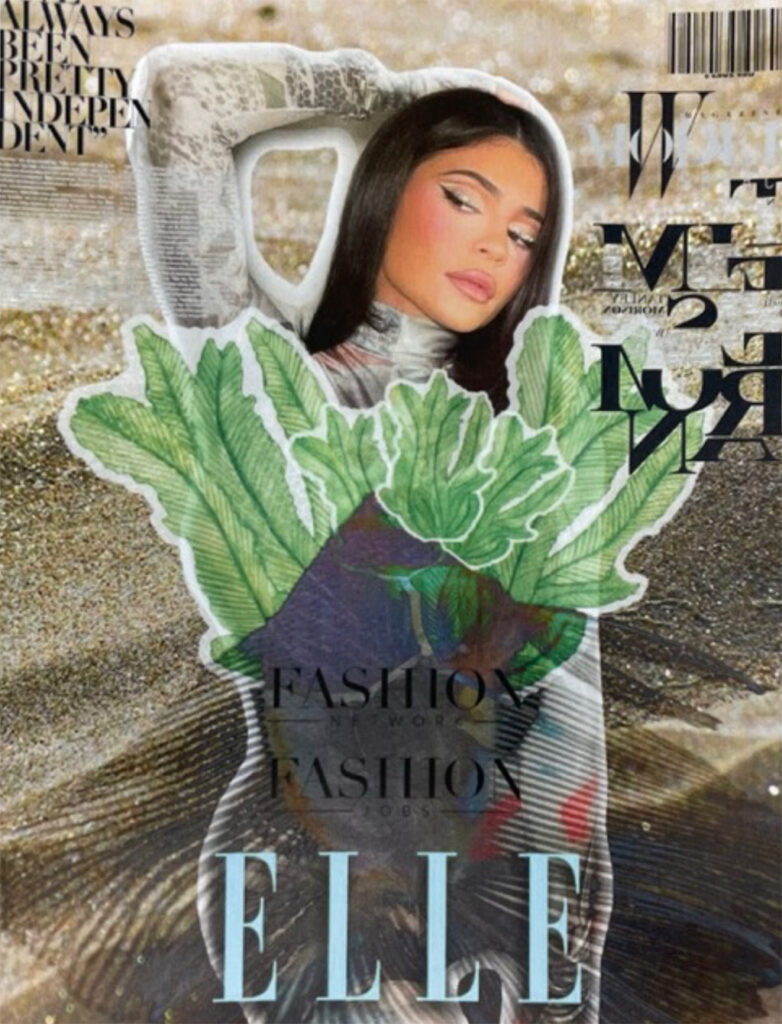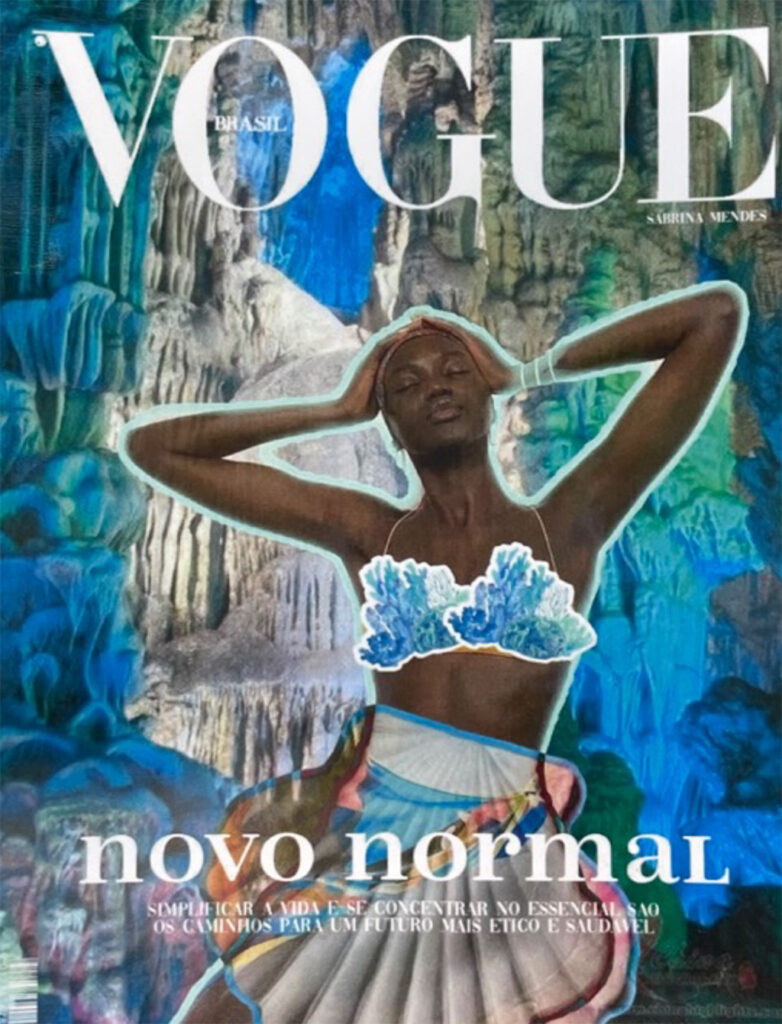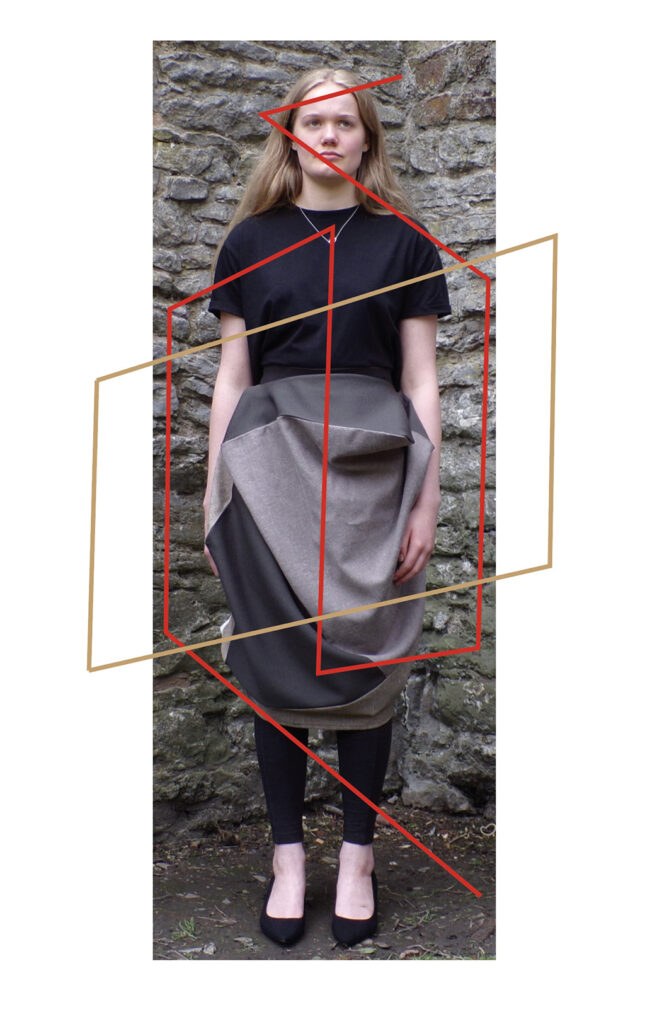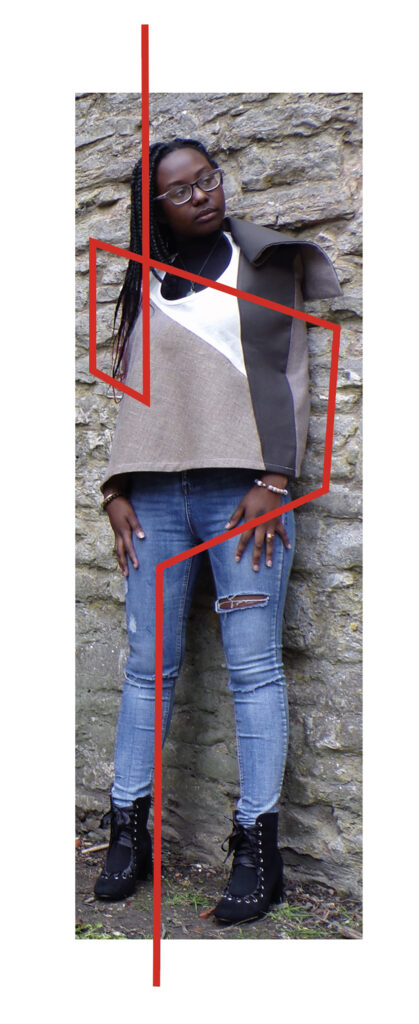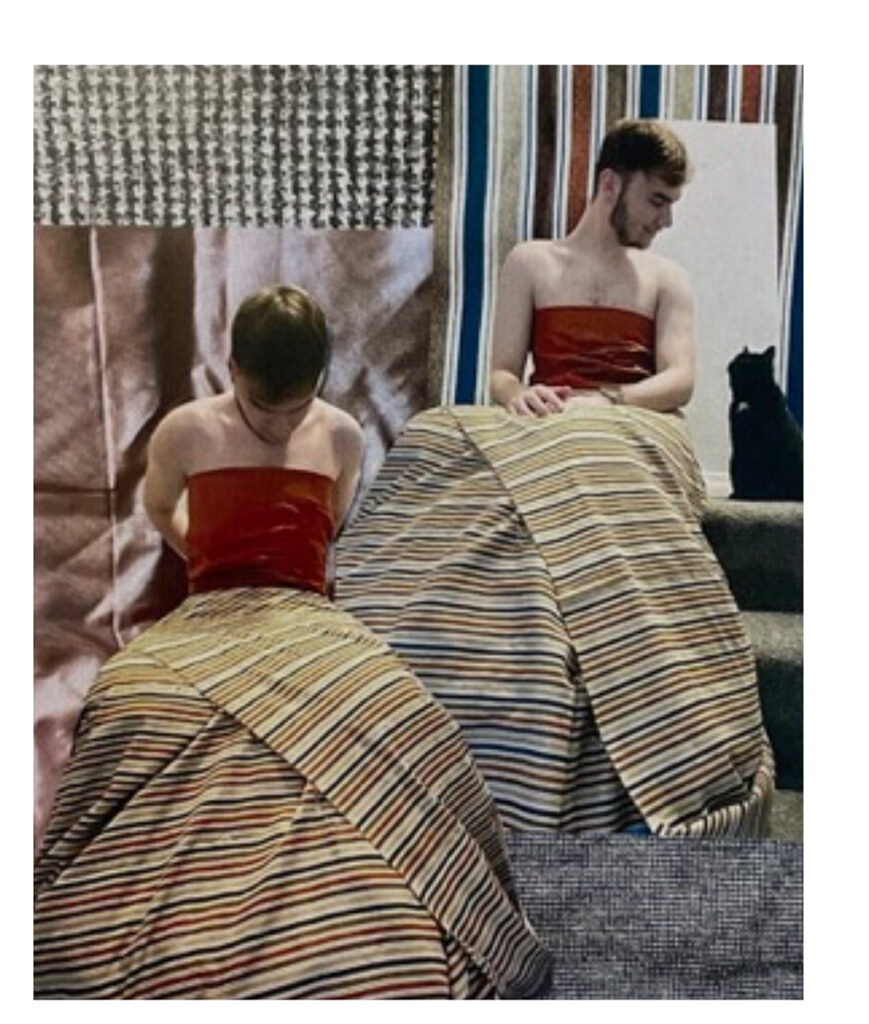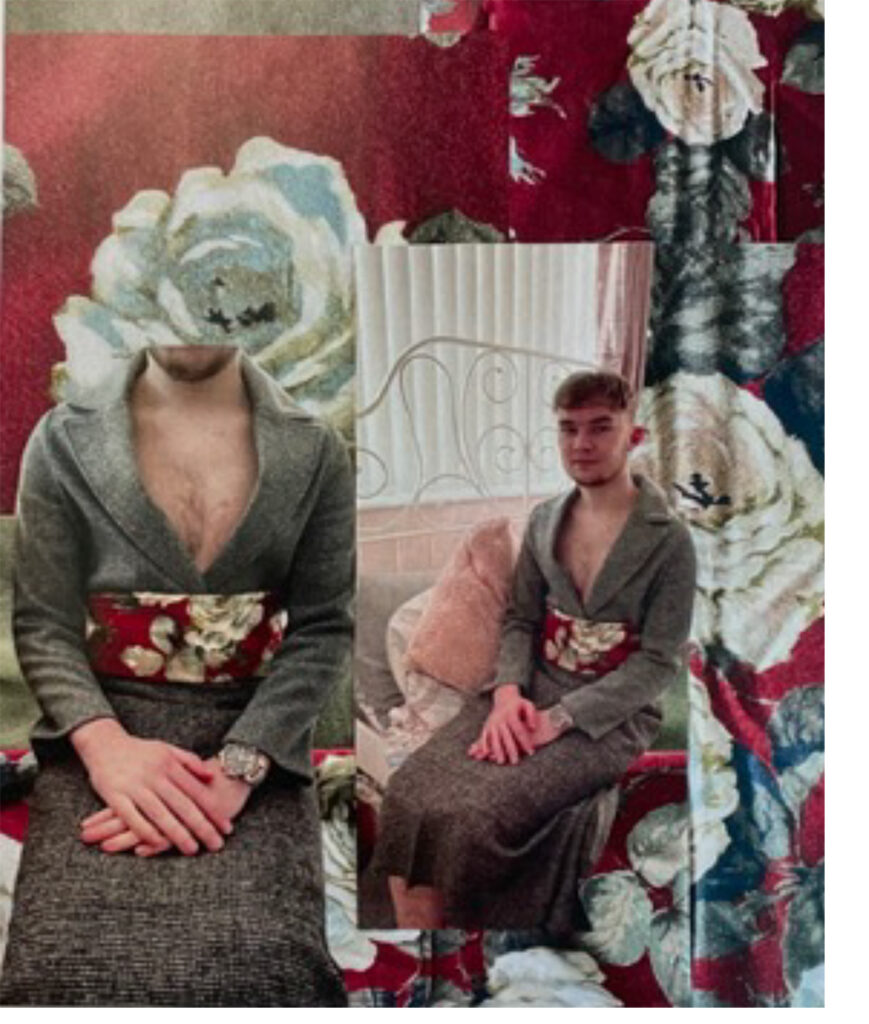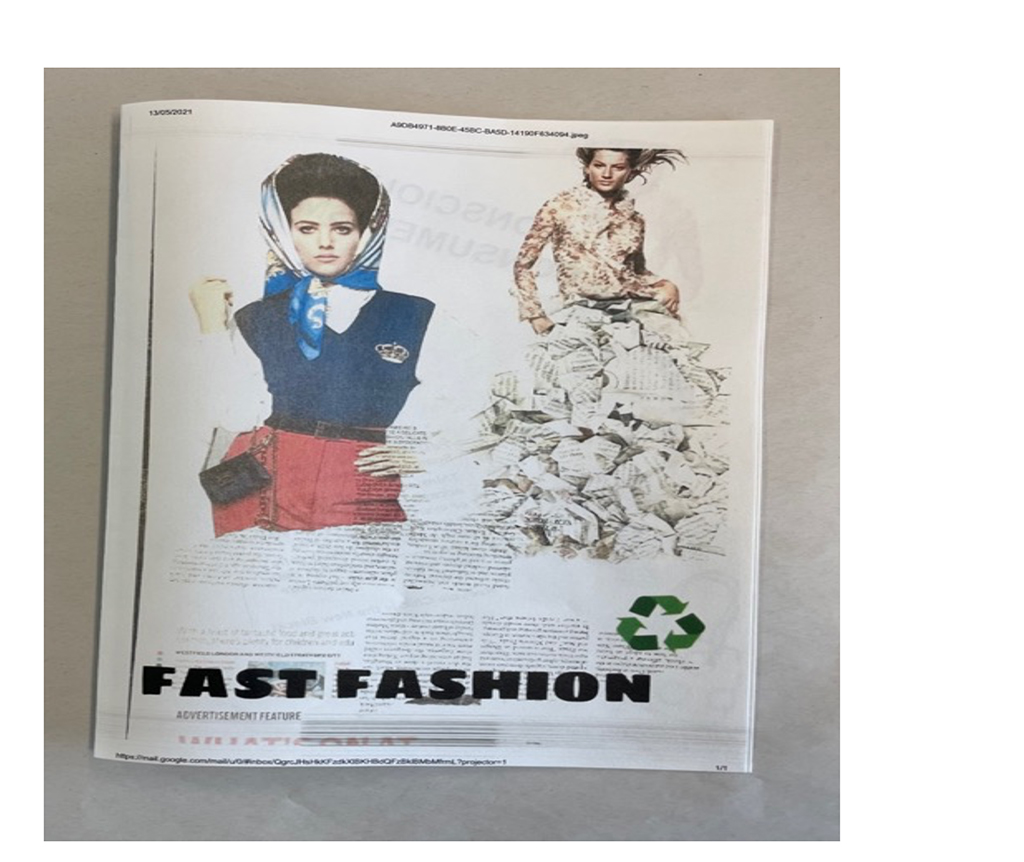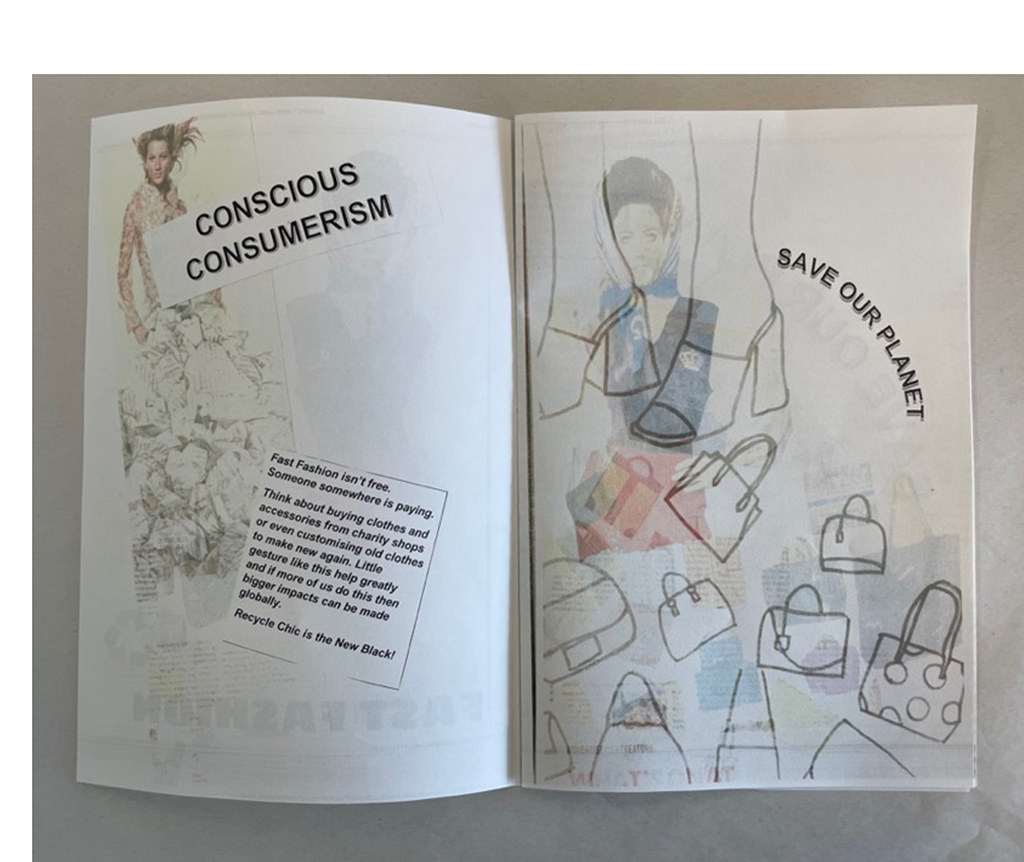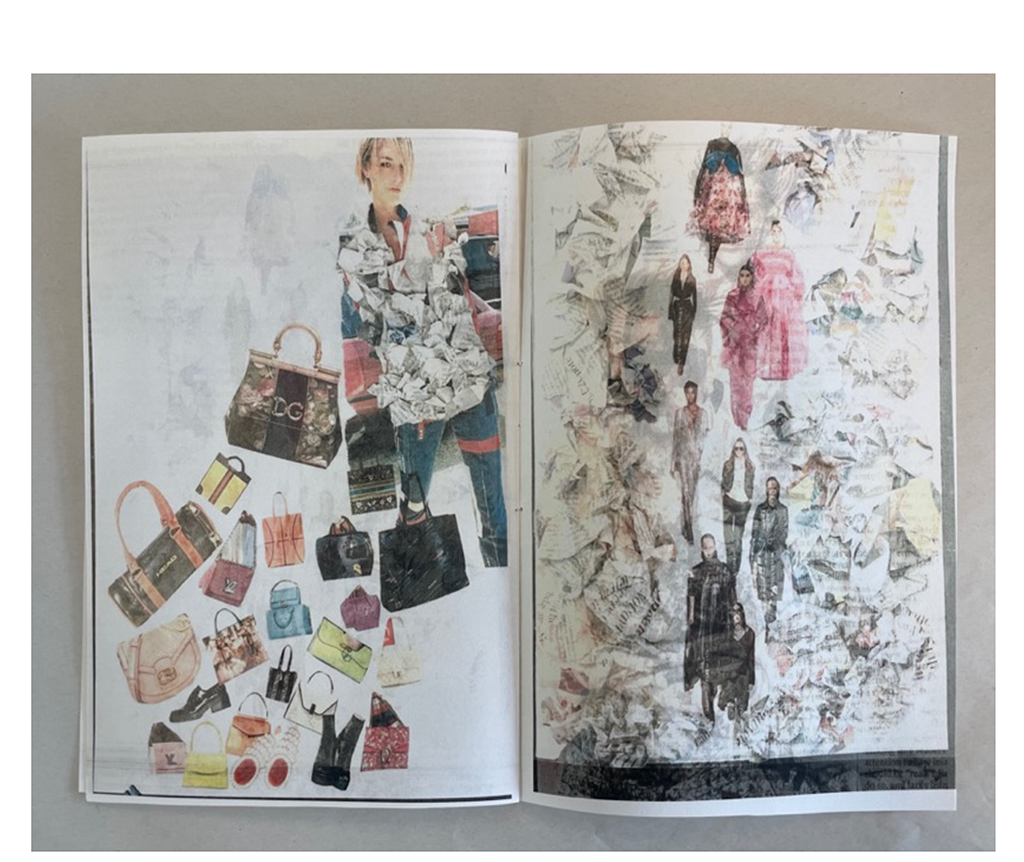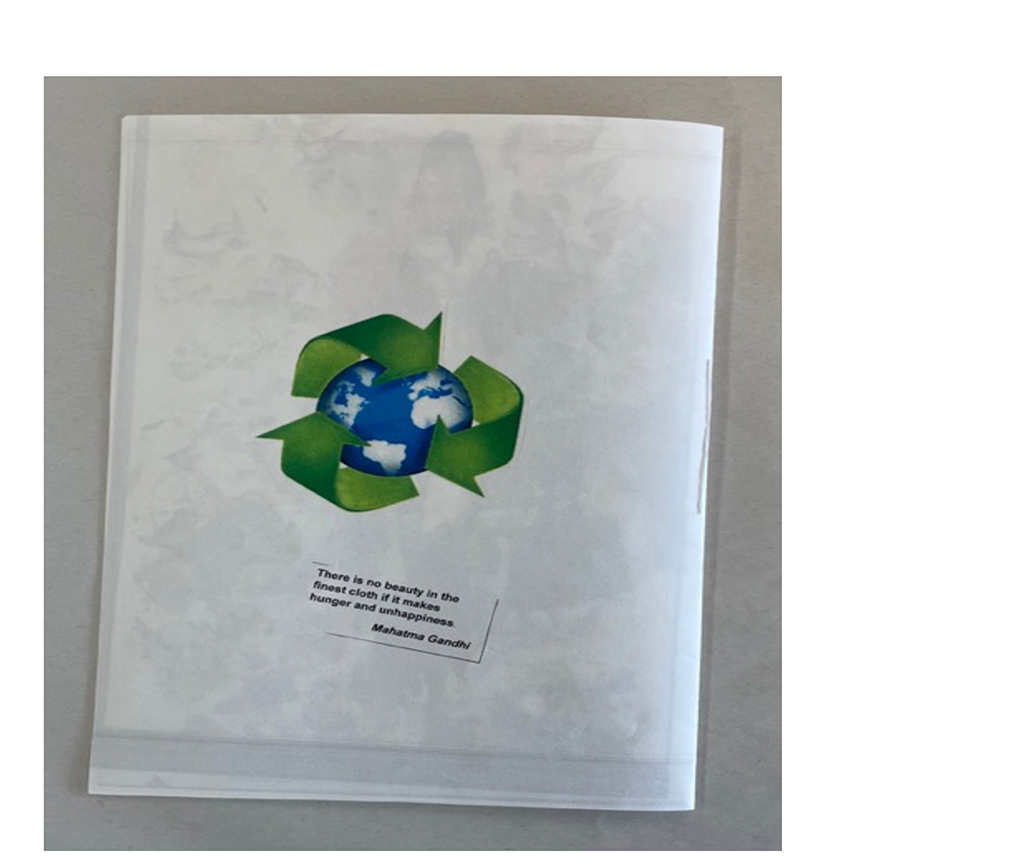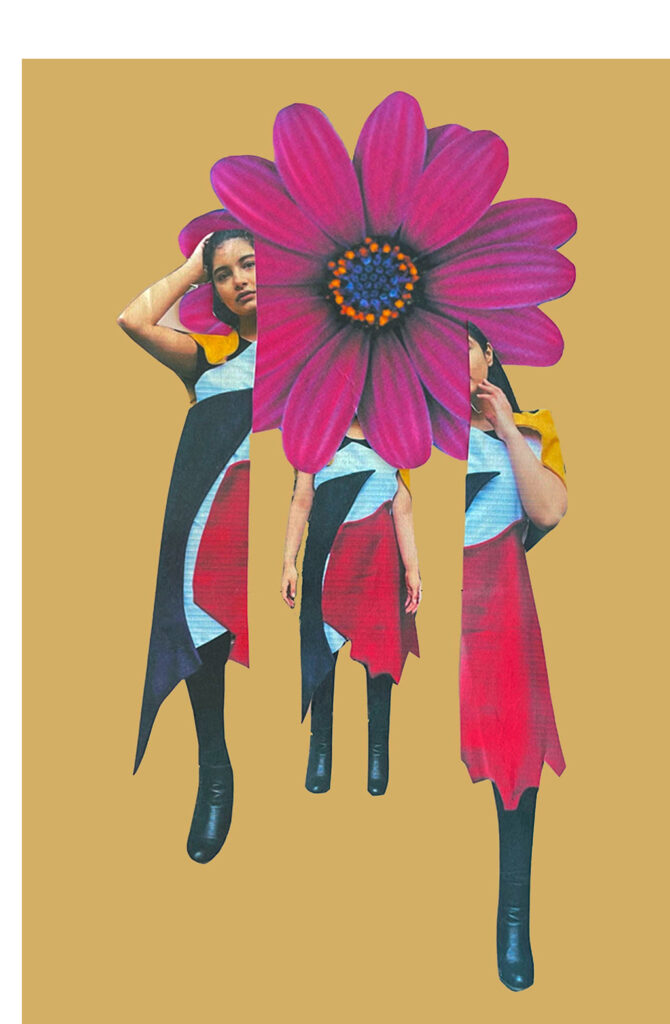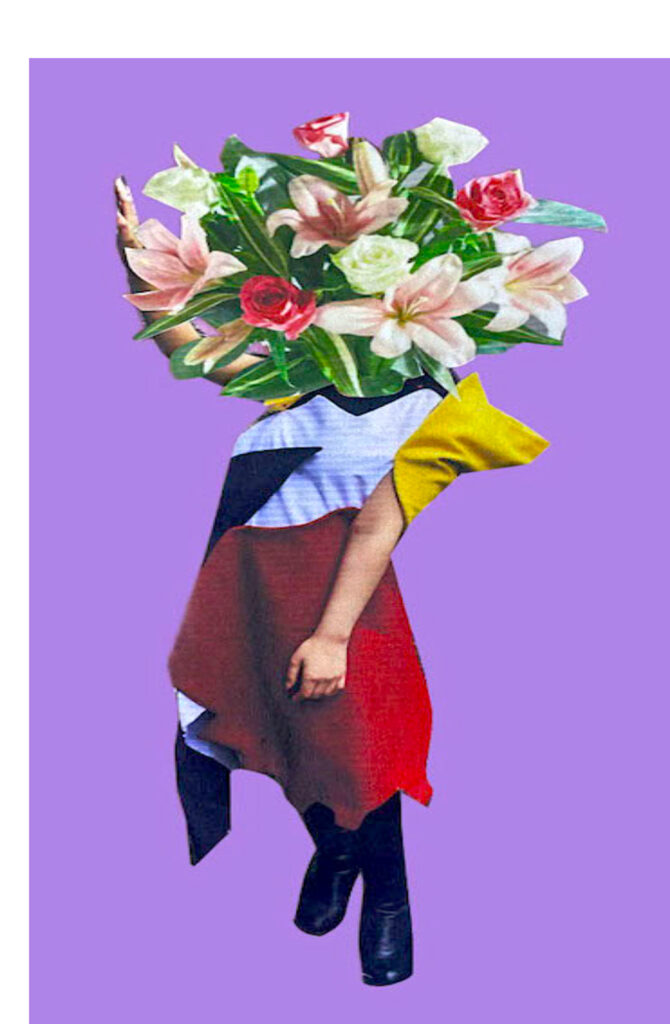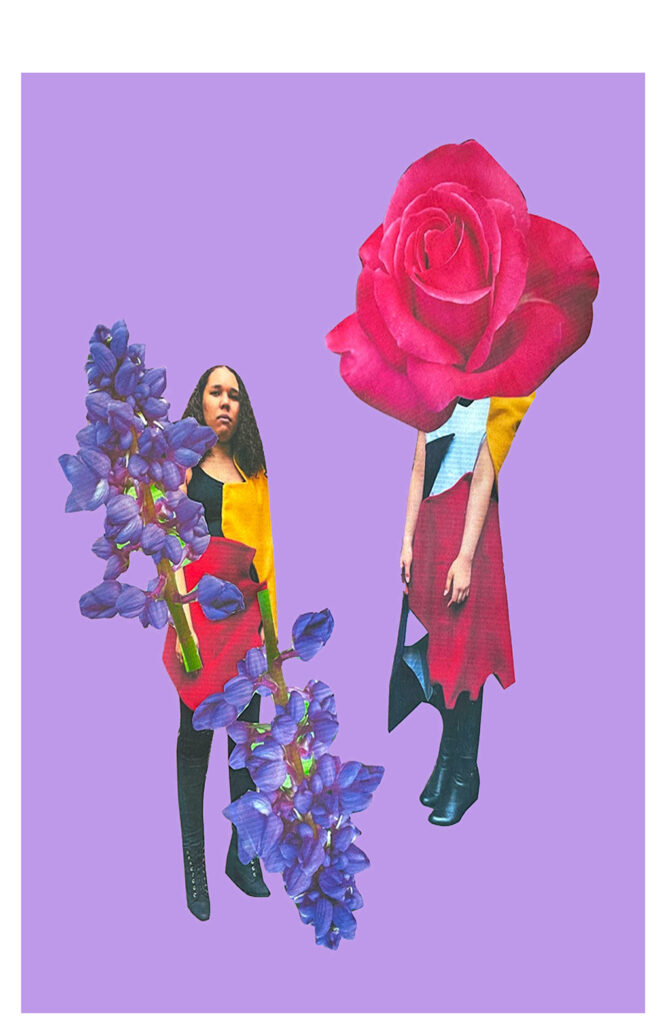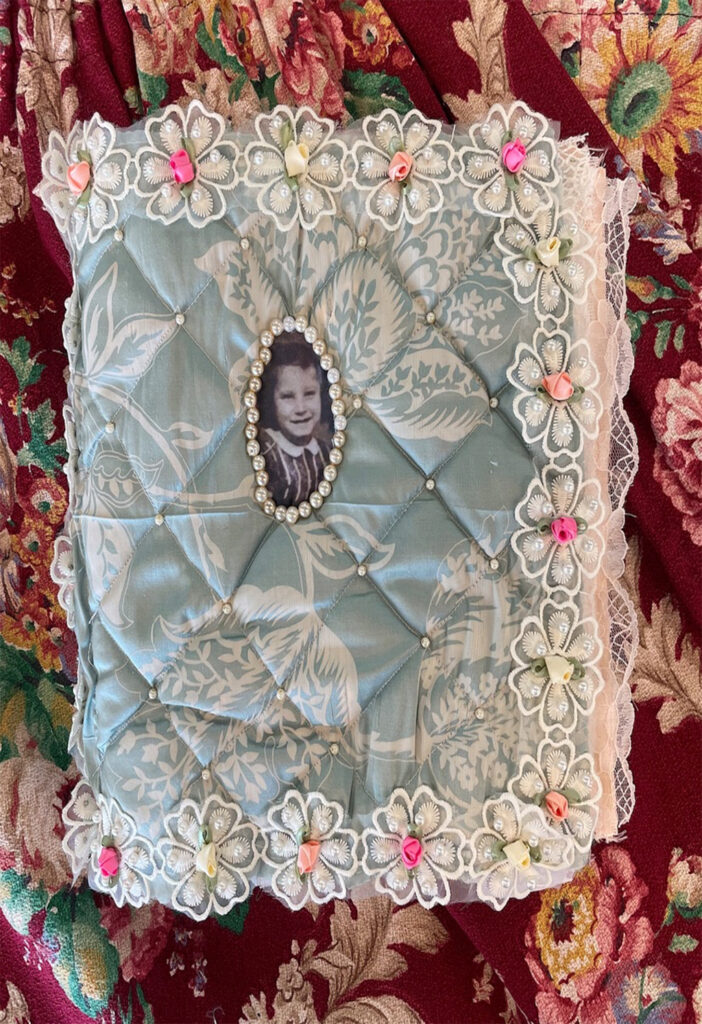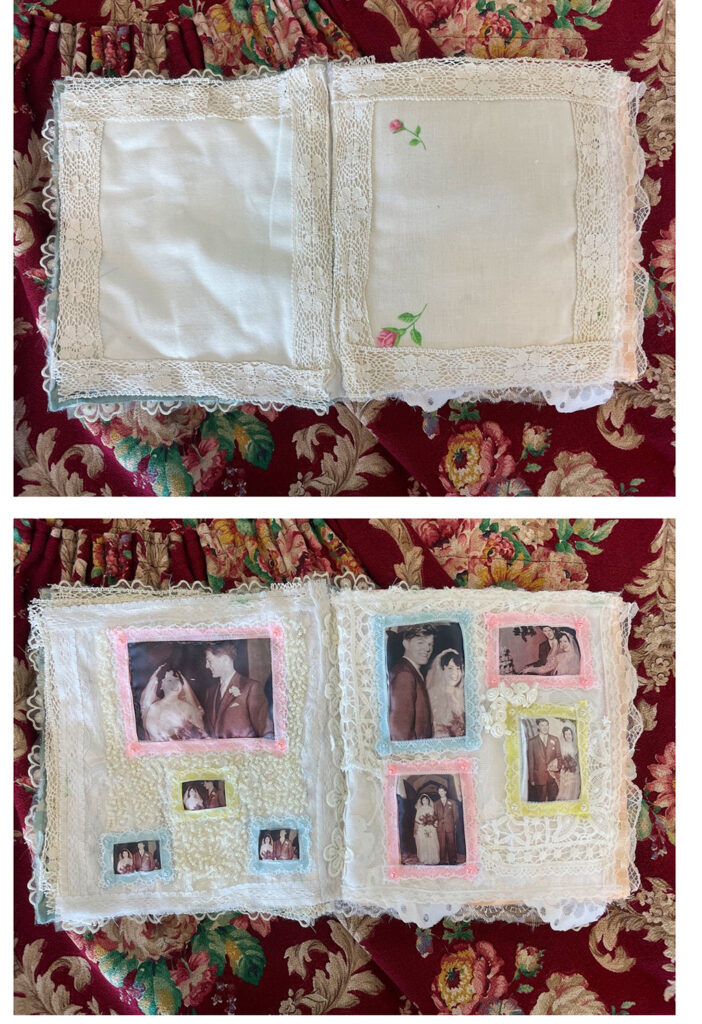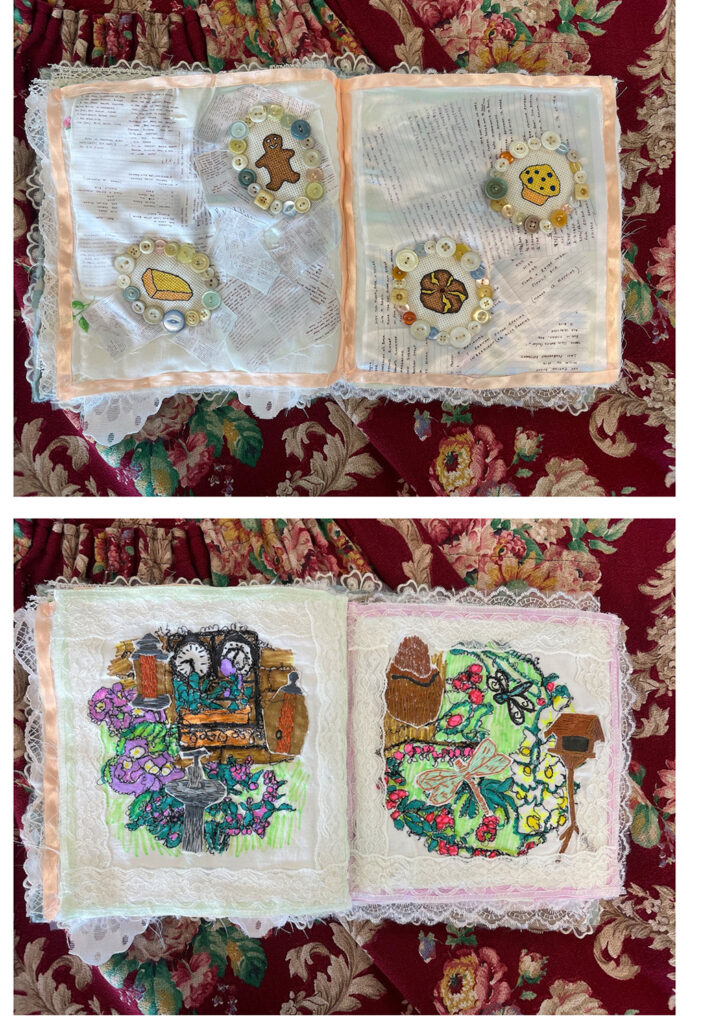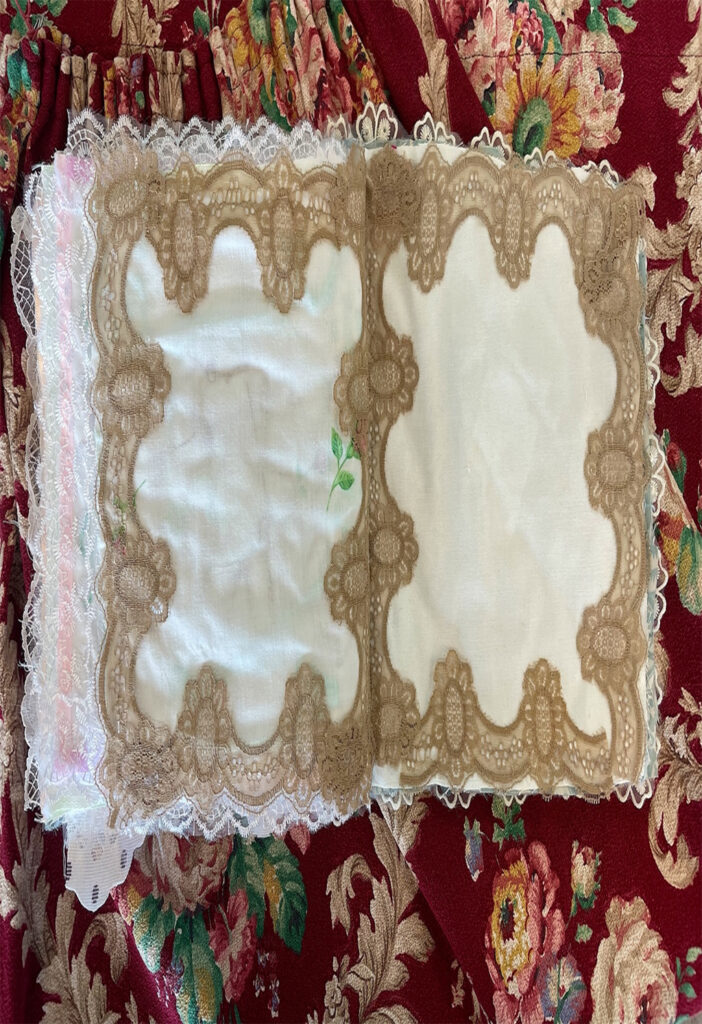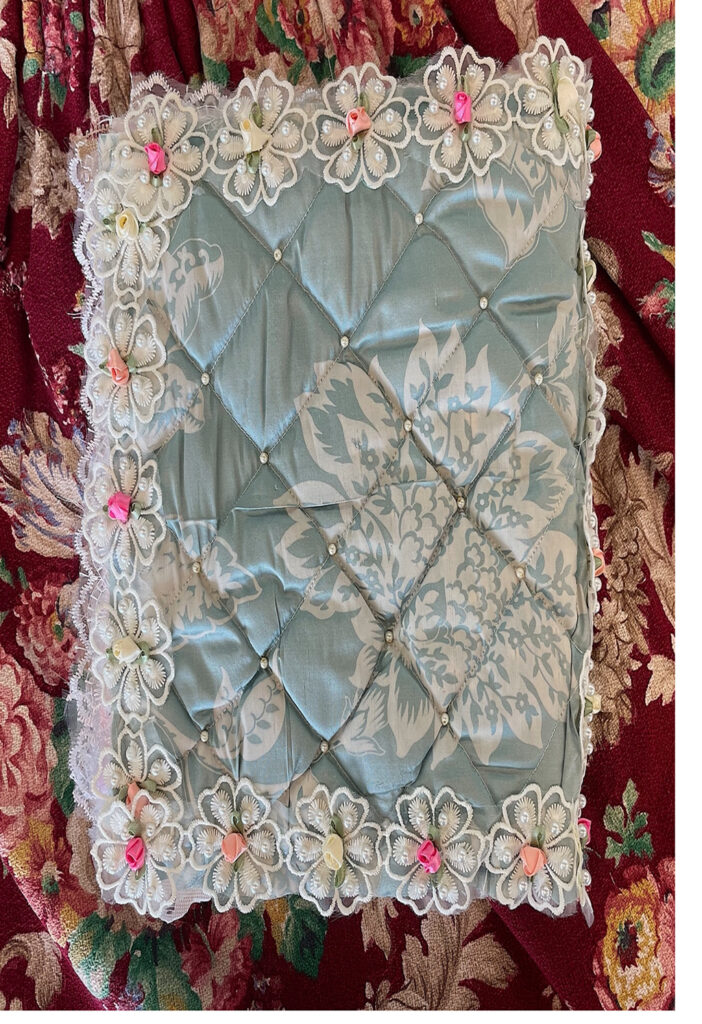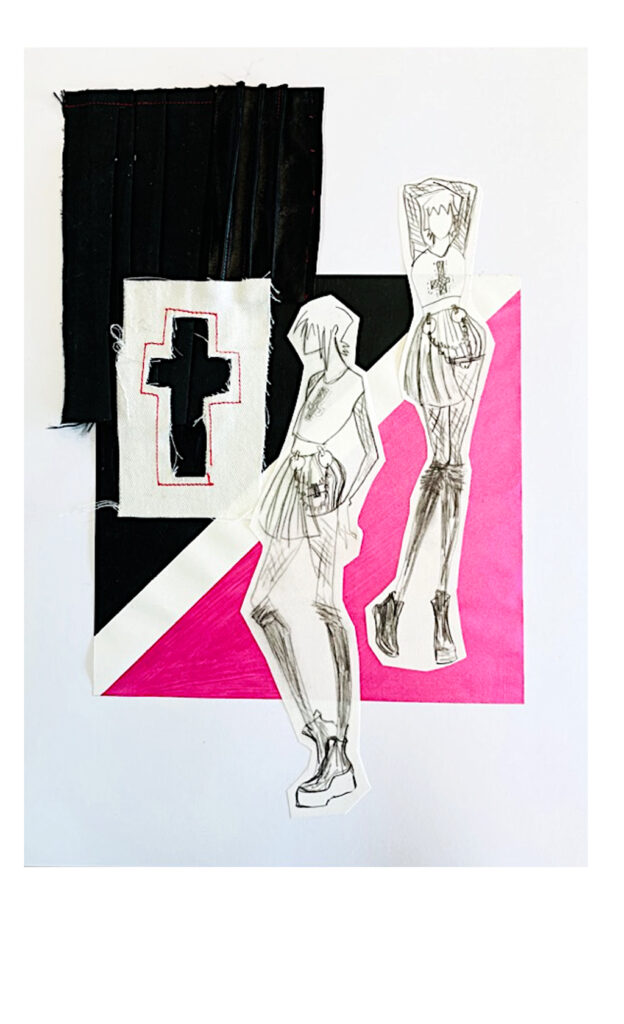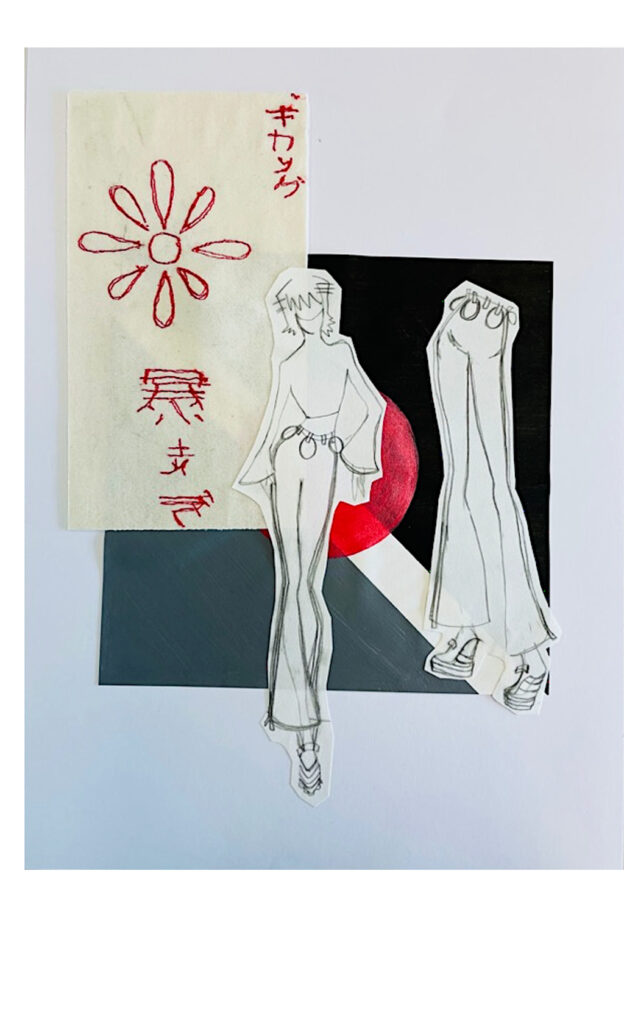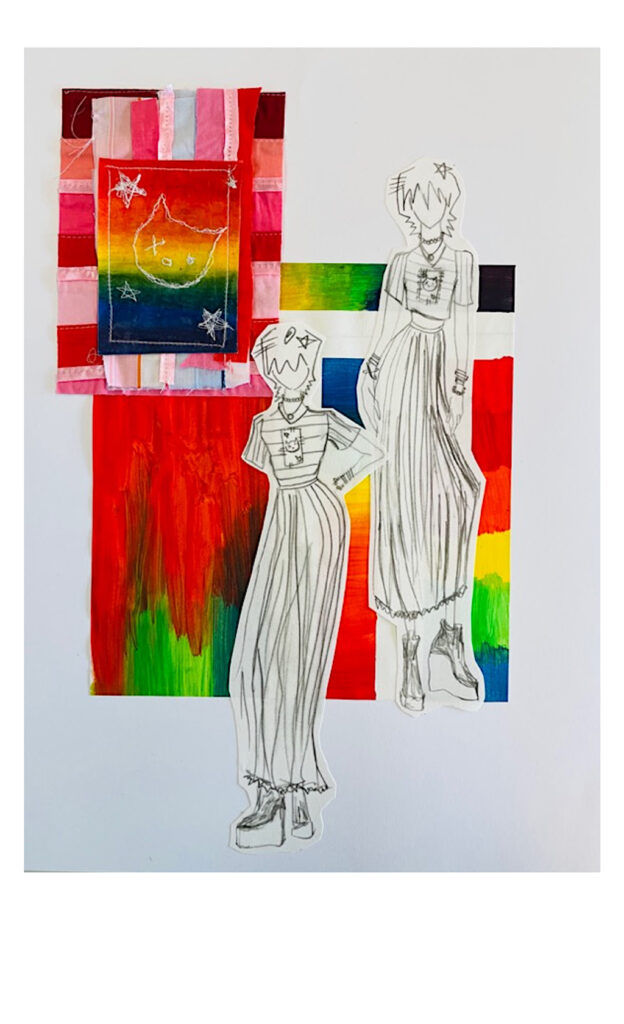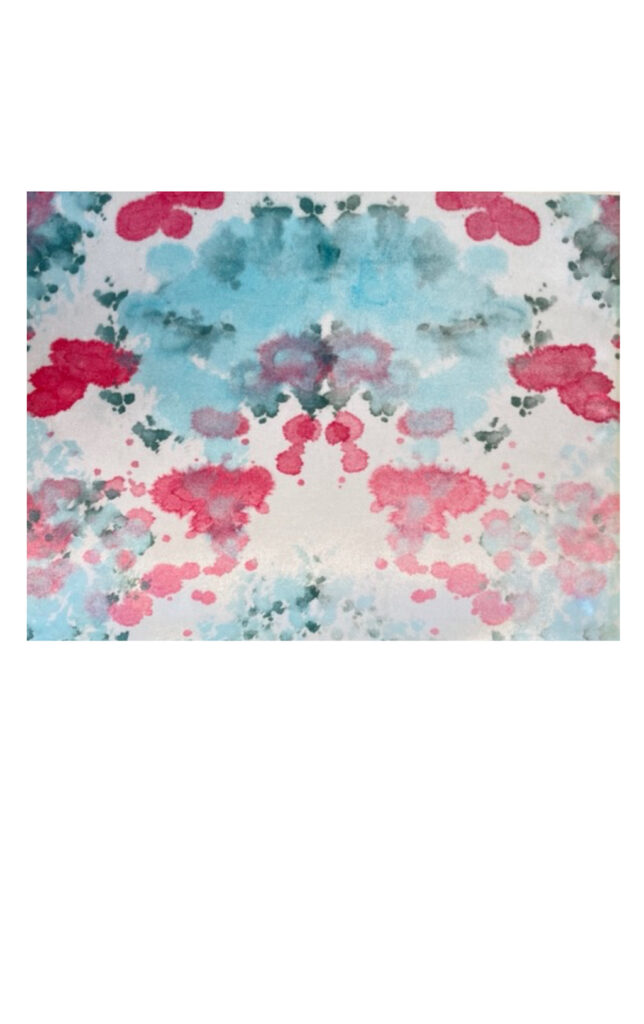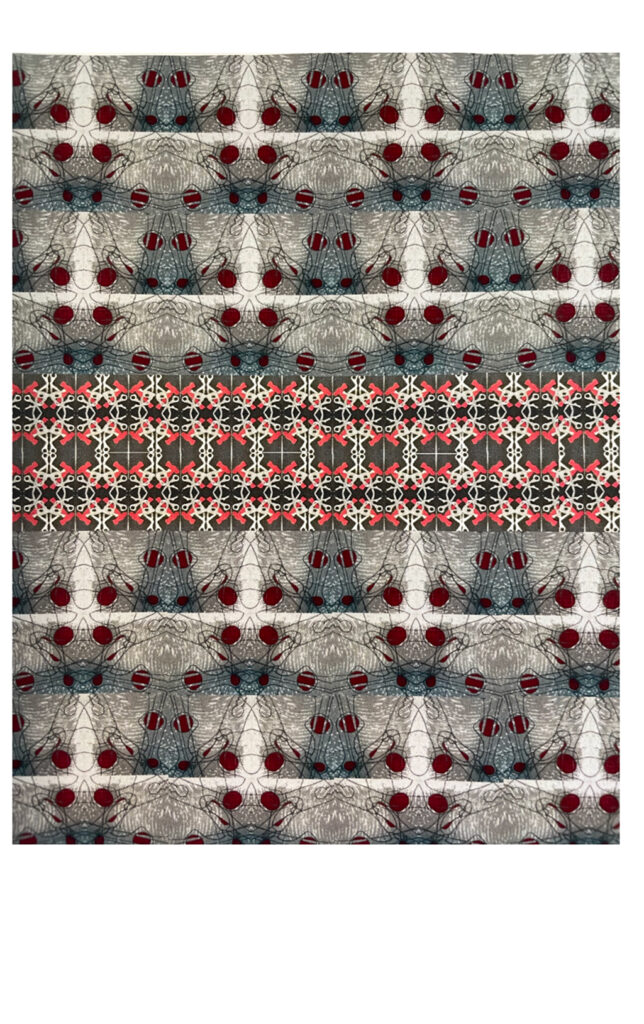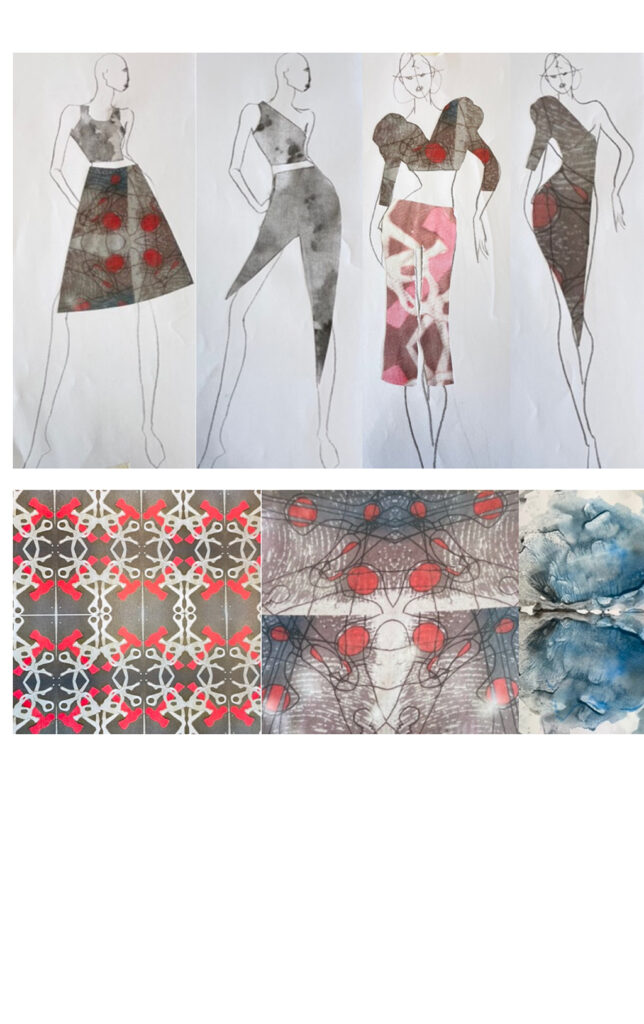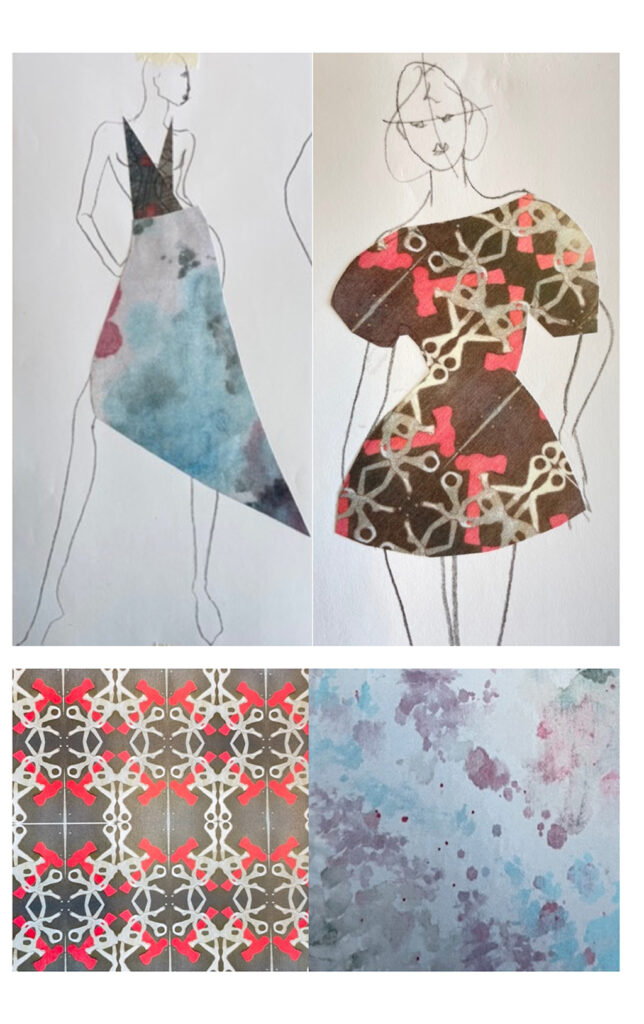
UAL EXT DIP IN FASHION AND TEXTILES: YR2
Naila Bibi
Previous Education: Dudley College (Level 1 Art)
Progression: Employment
The theme I chose for my project was about Honeybees. Bees are important for the environment because they collect pollen from different plants such as flowers, fruit and vegetables. They fly from one plant to another and make pollination happen so that fruit and vegetables grow more. If the honeybee is reduced in the world or die then this means that maybe gone will be the fruit and vegetables or not be in big quantity. Honey bees also make honey from the pollen which they collect and is used in many things that we eat or help with our skin. In my project I looked at the different bees and made drawings from them. I used the drawings to create hand embroidery and used different sewing machine techniques like, applique and cross stitch. I created a wall hanging with all the work I created to celebrate the honeybee.
With this project I improved on my time management skills and created lots of practical work. I have also learnt that taking risks and trying out ideas, even if you are unsure of them is ok as it helps you to create lots of ideas that you can choose the best from.
Kelci Edwards
Previous Education: Ormiston Sandwell Community Academy
Progression: BA (Hons) Fashion Business and Promotion- Birmingham City University
Fantasy and make believe has always been a part of the fashion world. It can be seen in catwalk shows or as part of a marketing strategy. It allows the viewer a moment to escape the realities of their working world or offer ideas on how to dress or style themselves for a social event. For my project I wanted to look into a range of different fantasies and make-believe scenarios and recreate my own for a magazine cover and inside spread. I created digital collages using a phone app that enabled me to layer separate elements together and blend them as one. I tried out several whilst testing them out on different magazine covers. The remaining images I used for the inside fashion story.
The work created during this second year has been intense and fast paced but has helped to develop personal confidence and organisation skills. It has been a challenging experience but has enabled me to find a direction that I want to develop further on the Fashion Business and Promotion Course at Birmingham City University.
Mia Honeyghan
Previous Education: Bristnall Hall Academy
Progression: UALAB Foundation Diploma Art & Design. Dudley College of Technology
For my FMP I want to tackle the design and pattern cutting aspects of my practice. With my earlier work I had a tendency to revert to shapes and silhouettes that were familiar to me as well as spending too much time on surface manipulations. Although this was fine to some level, I was hindering myself as a fashion designer and not investigating silhouettes through pattern cutting and construction. With this in mind I decided to choose a theme that would offer interesting points that I could grow and evolve from. Investigations led me to the Bauhaus movement of the early 20th century. This movement which started in a German art school ‘The Bauhaus’ became famous for its minimalist aesthetic and functional approach that influenced many designers over the years.
The work by Josef Albers, specifically “Multiplex A” threw open design possibilities and enabled me to generate a wide range of designs and silhouettes that I took forward into 3D modelling and pattern cutting experimentation. This resulted in a series of garments that could be worn in different ways such as a skirt becoming a top or a dress.
Vast learning experiences have been undertaken with this project from time management to critical thinking, as well as working in a more abstract and conceptual manner. These have enabled me to become much more creative as a designer and will take these to a higher level on the Foundation Diploma course in readiness for the demands of University studies.
Megan Lawrence
Previous Education: Halesowen College
Progression: BA (Hons) Fashion Design. Birmingham City University
With a recent project I looked at exploring how the clothing we wear is percieved in the general community. This led me to investigate gender sterotypes and the rise of androgynous fashions. Research into designers such as JW Anderson and Rad Hourani opened up a wealth of information as they had begun to challenge what appeared on the catwalks for either Mens or Womenswear collections.
Designers such as Maison Martin Margiela, Gucci and Comme des Garcons are further disrupting and blurring the boundaries of what is acceptable for Menswear, an area that has remained generally safe for many decades- singer David Bowie played around with this concept in the 70’s. Recently at the 2019 Oscars, actor Billy Porter appeared on the red carpet wearing a tuxedo/ballgown hybrid by Christian Siriano whilst singer Harry Styles wasn’t afraid to experiment with fashion in the public eye by wearing dresses, skirts and make-up whilst still looking masculine on the cover of Vogue Magazine.
This idea of Gender Bending”, clothing that challenged the rigid, binary definitions of dress became the basis for my styling project. I played around with fabrics and female items of clothings/accessories and put them together on a male model in ways that would offered creative play and joy in being able to wear what you wanted.
A great deal of learning and critical thinking has encouraged on the course especially with time management. By acting on these I have been able to generate a diverse portfolio of creative work. I plan to extend and explore much all these valuable skills more widely on the Fashion Design course at Birmingham City University.
Rosie Malcolm
Previous Education: Sandwell Academy
Progression: BA (Hons) Primary Teaching and Education
Currently we have been dealing with a serious pandemic that has affected not only the whole of the UK but also the rest of the world. With the concerns of shortages, and shop closures I began to think about the amount things that have ended up in the waste, unsold or left in factories. This has impacted the fashion industry in that clothing and accessories were not purchased and there were rails and shelves of unsold items. I began to ask myself, what would happen to these things and was there a need for so much mass production, but most importantly what effect has this had to the environment? With this in mind, I wanted to create a body of work that addressed this waste issue and to promotes sustainability. I produced collages and visuals for an info-booklet that could be picked up and passed around by everyone to help raise awareness of waste and start conversations on they could play a part in sustainability and zero waste.
A lot of learning experiences have been undertaken with this project from time management to critical thinking. These have enabled me to become much more focused as an individual and will further develop these valuable skills at University.
Sarah Moore
Previous Education: Beacon Hill Academy
Progression: BA (Hons) Fashion Garment Technology. Birmingham City University
My project was entitled ‘Architecture of Flowers’ where I focused on the irregular shapes and the silhouettes of flowers. With my previous work I had a tendency to focus on the surface aspects of my projects, often neglecting or leaving too late the design play around shapes and silhouettes. In doing so I restricted myself with learning valuable skills such as design development and pattern cutting – two areas that are important in fashion design. My first impressions were that flowers came in a wide range of shapes and forms, some with more curved rounded petals whereas others have straight angular features. Closer inspection revealed other sections such as leaves, stamens and sepals, details which I felt would allow me to delve into when investigating possible shapes for design work. Through pattern cutting and design investigation I was able to generate a very abstract respose to the project where separate shapes were created and placed on the body in different ways. This provided me with a wide range of possible outcomes and created a bigger collection than just designing one garment.
I have been pushed to think more creatively and inventively this year which has helped me to become a stronger designer. Planning and critical anlysis has played an important part in the project. I hope to build on these skills on the Garment technology Course at Birmingham City University so that I am better prepared for the world of work.

Navdeep Najran
Previous Education: Bristnall Hall Academy
Progression: BA (Hons) Fashion Design. University for Creative Arts (Epsom)
The work I created for previous project enabled me to prepare for my FMP however on reflection I found that I had spent a large amount of time on the surface and textiles aspects of the work leaving me little time to investigate the fashion design and construction side of my studies. To ensure that I succeeded with my final work I decided to investigate a concept that allowed me to focus just on shapes and silhouettes and in doing so explore and exploit pattern cutting and construction to the best of my abilities.
Designers such as Rei Kawakubo for Comme des Garçons, Craig Green or Iris Van Herpen, are wildly exploring abstract shapes with interesting motives. Through this exploration they have been able to play with pattern cutting and construction skills to produce unusual and almost deformed silhouettes.
I decided to delve into the basic fundamentals of shapes and silhouettes to create abstract outcomes. The intention was to explore mundane geometric shapes such as squares, circles and triangles and in doing so, investigate the relationship between unusual designs and the human body. Square dresses became fluid, circles had the ability to add sensuality to the form and rectangles when wrapped around the body created flow. All garments constructed could be worn not only in different ways but combined together in multiple ways that generated a large collection of sophisticated clothing for women.
What I have learnt this year is that working closly with staff and acting on their valuable suggestions has opened up ways of thinking and working that has injected fresher perspectives in my fashion work which I will take on more willingly on the Fashion Design Course at the University for Creative Arts in Epsom.

Jodie Pountney
Previous Education: Earls High School
Progression: Employment: Dudley Canal and Tunnel Trust
The recent lockdown has been incredibly hard for me, due to my anxiety I was very afraid of visiting and talking to my grandma, however as things got better, I was able to spend a lot of time with her as she had been very lonely and fed up in the pandemic. I built a really close relationship with her and this improved her life and mine. Through this time, I learnt a lot about her life which I didn’t know before. Learning about her childhood and being shown her collection of china, jewellery and even her own embroidery work.
We also connected over our love of jigsaw puzzles and she had been teaching me to bake. With this in mind I felt it was an idea to create and develop biographical work around the life of my grandma, taking inspiration from her life stories and her belongings. I looked into work by contemporary artists and designers such as Grayson Perry and Tracey Emin, who created biographical work whether about themselves or others to add contextual depth to my project which resulted in me creating a fabric-based photo album full of imagery that were linked to her life.
I have learnt this year that taking risks and trying out ideas, even if you are unsure of them is ok and help you grow as a person. These can be further developed and offer other options that I might not have considered. I hope to take this newfound confidence and apply it to all aspects of my life and careers.
Tia-Ann Rowledge
Previous Education: L3 Art & Design Dudley College of Technology
Progression: BA (Hons) Fashion Design & Technology. Manchester Metropolitan University
My FMP revolved around Japanese street fashions and the different fashion subcultures found within the Harajuku district in Tokyo. The Harajuku street fashion has long been known for its expressive and cartoonish styles, often very flamboyant and colorful. Japanese youth have a sense of bravery and adventure in their fashion outlook and there is a strong play on eccentricity, fusions of patterns and co-ordination of accessories with nods to art-based influences such as Pop Art.
I was drawn to this very unique and fluid style with the fusing together of different subcultures and felt that investigating into this would allow me to take many influences and ideas and meld them into a personal response that is fun and eclectic. Through research and practical investigations both in drawing and textile techniques, I created a range of designs that were inclusive to all genders and accessible so that it would be possible for anybody to wear with confidence.
I feel the most successful part of my second-year experience has been the growth and development I have made with practical skills and approaches to ideas. I have started to become more experimental and braver with what I do and through staff encouragements able to take practical risks more openly. I look forward to developing my newfound confidence on the Fashion Design course at Manchester Metropolitan University so that I am better equipped for the world of work.
Simran Simplay
Previous Education: Colton Hills, Wolverhampton
Progression: BA (Hons) Textiles Print & Surface Design. Birmingham City University
I often find myself drawn to stories, films and documentaries that revolve around serial killers or murderers whether as fantasy story telling or real-life adaptations. For my FMP I wanted to look into the range of items used by serial killers and find ways to incorporate them into textile designs for surfaces. It may appear sinister to use these objects as a design inspiration but I have come across works by many artists and designers who have looked at unconventional starting points to create work that appears beautiful but are unsettling on closer inspection.
Textiles designers Timorous Beasties subverted the traditional Toile de Juoy by replacing romantic scenes with images associated with the dark side of the city in their work Glasgow Toile which included images of gunmen, drunks and drug addicts. I approached my work with this similar ideas of disruption where an image may appear attractive at first glance but shocking on closer inspection. Initial observational drawings of knives, ropes and hammers became layered and distorted.
These were then turned into inventive patterns through experimenting with repeat structures. Through the process or digital manipulations and sublimation printing, I was able to generate a body of work that at first glance looked like creative print designs but on closer inspection, hid a dark story. The prints can be used not only as prints on fabrics but on different surfaces such as wallpaper and furnishings.
What this year has taught me is that research and drawing investigation has played an important part in the creative process and allowed for a wide range of work to be created which could be narrowed down to the most successful. Year 2 has been a challenging experience but it has enabled me to find a direction that I was most successful in and one that I want to develop further on the Print and Surface Design Course at Birmingham City University.

